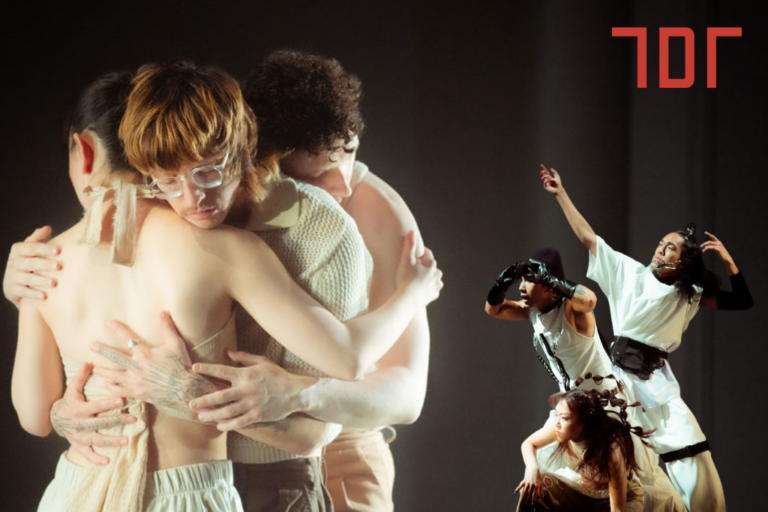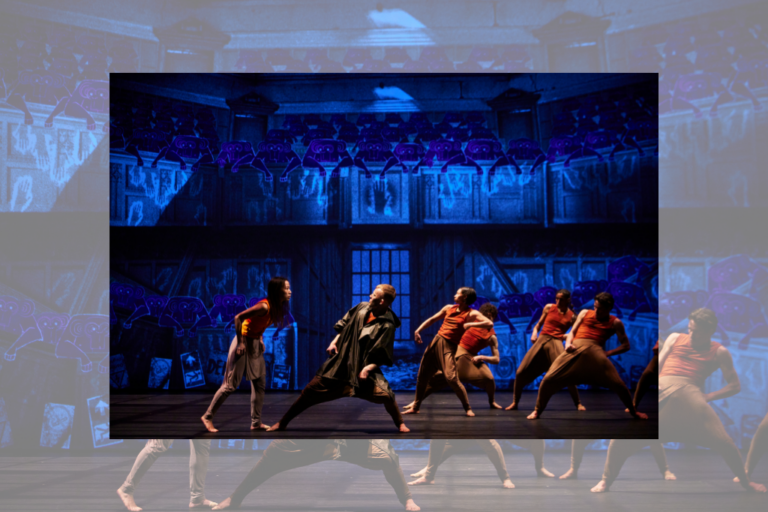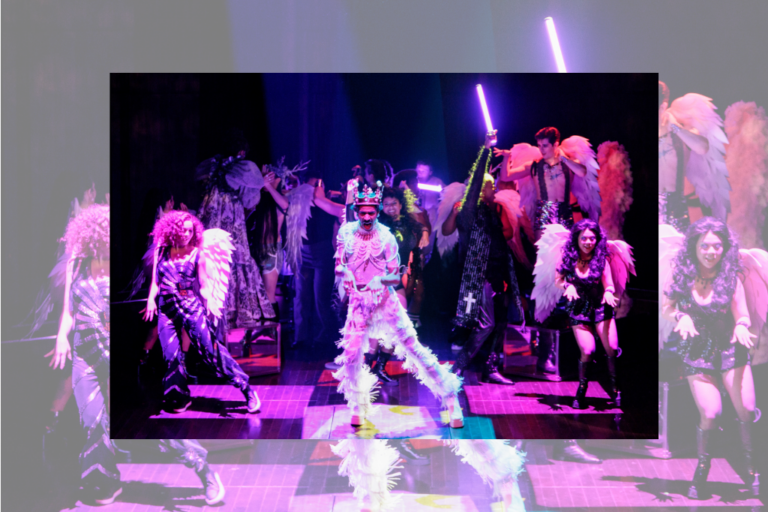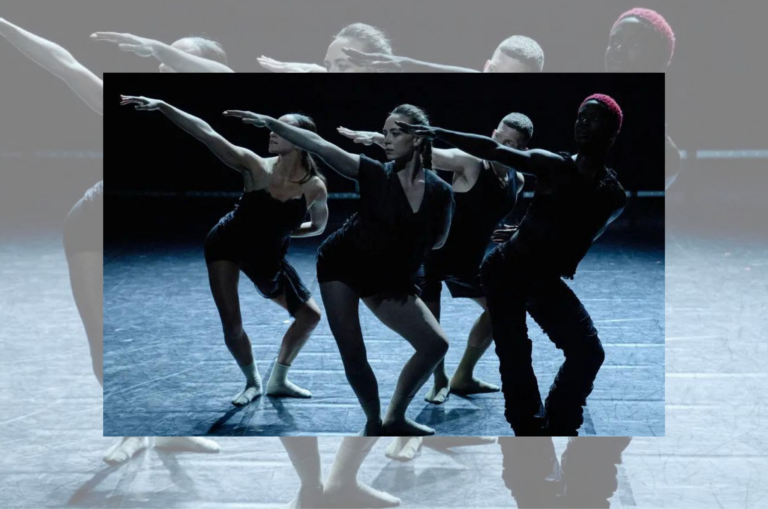REVIEW: Miigis: Underwater Panther at Red Sky Performance
Content warning: this review discusses residential schools and lingering trauma.
Can dance tell a story? Yes; but not conventionally. When words are not at a choreographer’s disposal, movement can embody the things that conventional language can’t.
Red Sky Performance’s Miigis: Underwater Panther (at Canadian Stage’s Berkeley Street Theatre) uses dance to illustrate a prophecy, where the Anishinaabe must move urgently from the ocean to the Great Lakes. To embody this journey from salt- to freshwater, Teme-Augama Anishinaabe director and choreographer Sandra Laronde employs six dancers and four live musicians to tell this legend through movement over its 60-minute run time.
As a settler previously unfamiliar with this Anishinaabe prophecy, I knew dance as a storytelling medium could inform me more about the emotions and abstractions of this narrative than the word-for-word details. However, one story that Miigis: Underwater Panther tells with shocking clarity is that of the residential school system — indeed, some may find this imagery upsetting.
Yet the result of weaving together Anishinaabe myth and history is an expertly constructed, often devastating performance. Miigis: Underwater Panther conveys the great joys and deep fears of migratory upheaval, of constantly discovering new worlds that shatter as soon as you start feeling comfortable in them. Laronde and Red Sky Performance haven’t just made a great performance; their work epitomizes how meaningful, gripping, and profound great performances can be.
Miigis: Underwater Panther takes time to reach its peaks. Composer and musician Rick Sacks’ live musical accompaniment is the consistently superb shepherd of this journey. Something is so special about dance performances with live music. When dancers respond conversationally to musicians, it elevates dance past the choreography on its own. Here Ora Barlow-Tukaki, an Aotearoa/New Zealand multi-instrumentalist of Te Whanau-a-Apanui and English descent, uses shells, flutes, and voice to create soundscapes of wind and birdsong. Alongside musician Ian De Souza is Wikwemikong First Nation Ojibwe singer Marie Gaudet, who offers climactic vocalizations.
The piece begins with the dancers slowly emerging from the structure of a hollowed-out boat. This prop, by set designer Julia Tribe, is a defining feature of the introduction. It is initially a place of shelter, where the dancers rest before performing an intricate gestural phrase. Tipping the boat to its upright position, the dancers maneuver the ship, navigating waters that become increasingly choppy until dancer Kristin DeAmorim falls off the side and plunges into the waters below.
Laronde’s choreographic choices exemplify how Miigis: Underwater Panther builds to greatness from simple beginnings. The emergences from the boat are uncomplicated; dancers ponché hanging off the side, hold their feet to their heads, showcasing their flexibility. This more balletic performance feels too pretty; there isn’t an urgency yet. But there will be. DeAmorim performs a solo that gains sentience underwater, her stretchy limbs otherworldly with high kicks, deep lunges and intricate floorwork. Embodying legendary natural forces, DeAmorim is joined by other dancers, their movement continuing to escalate in intensity.
But when dancer Jason Martin stops the proceedings by blowing a dark dust onto the rest of the ensemble, Miigis: Underwater Panther sublimely ties Anishinaabe myth with Anishinaabe history. Video designer Febby Tan’s compelling multimedia backdrop, previously animations of water and forests, cuts to a jarring montage of residential school photos. The music stops, the dancers exit the stage, and the silence rings as the implication becomes clear. The piece’s first half is not just a myth. Rather, this migratory upheaval has prophesied the devastating recent history faced by the Anishinaabe. This break is as overwhelming as it is insightful, and it seismically shifts the tone and direction for the remainder of the piece.
The hyper-theatricality of the following sections, where terrifying facial expressions set off guttural, tortured body movements, emphasize the complex truths hiding behind the first half’s pretty performances. As the lights turn red, the music recommences, and Martin emerges as a demon that levitates confoundingly quickly across the stage. Martin masterfully performs something tortured, spinning with energy of hellish forces, his hands seemingly emerging from his face.
Yet more intense are the following vignettes that portray residential school victims. In one, dancer Daniela Carmona dons a simple white dress as priests forcibly mime the cutting of her hair. In perhaps the most compelling moment, the boat returns and becomes the boning of a giant white dress worn by dancer Moira Human-Blaise. The live music is replaced by a classical music track, and Human-Blaise laughs and cries manically as she tiptoes around carrying her massive makeshift dress. For a performance that straddles myth and reality, this moment settles in the middle, seeming to display the true emotions experienced by these survivors.
These climactic moments ultimately dissolve into a final number where the musicians and dancers alike reach their full fervor. And altogether, Miigis: Underwater Panther is a riveting proposal for dance as a means of Indigenous storytelling. It pairs demons of myth with residential schools of sobering reality, waters that are volatile on the surface yet calm when drowning beneath them. And like most prophecies, this performance will stay in your mind long past the hour it takes to watch it.
Miigis: Underwater Panther runs at Canadian Stage through January 29. Tickets are available here.















Comments